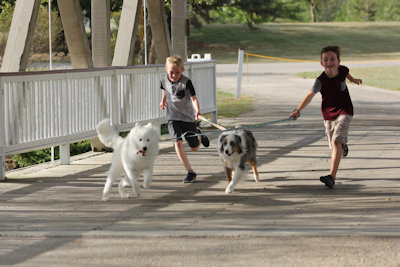We love our pets so much, it’s so important that they feel part of the family while they’re with us. So in order for us to understand our dogs on a deeper, much stronger level, we need to find a common language and that means of communication is training and command. A family needs to be united when training a new furry relative, as it’s very important for everyone to relate to the dog and teach them that all family members are equally important and there for him or her.
Check out these nifty training tips to help you utilize your family’s training ability, as well as help your pooch become a part of it.

Photo by Sheri Hooley on Unsplash
Before we dive into the training tips, here are three of the most popular family-friendly dog breeds to consider if you’re still searching for the perfect animal companion for your family.
Border Collie
Border Collies are by far one of the smartest dog breeds out there, but also with a mild and approachable temper that makes them perfect for kids and playing.
A Border Collie’s size is also very convenient for homes, as they are not too big, but big enough to play ball, run around and participate in all outdoor family activities. Their intelligence will for sure quicken the process of training and you’ll be surprised how much a Collie is able to learn and overcome.
Golden Retriever A Goldie has become an epitome of a suburban family dog and there’s a reason why. Their loyalty, friendly demeanor and great love for children are what makes them perfect for family life. They are great at just chilling and laying around, but also don’t miss the outdoor fun, swimming and playing around. They are also considered a very smart breed, so try out teaching them some cool tricks.

Photo by Alison Dueck on Unsplash
Dog training is not a joke, although it can be a fun and engaging family activity. Before you start implementing any changes, make sure everyone in the household is on the same page. If your goal is to keep the dog out of the bed, your effort and trouble won’t matter if the kids keep letting him or her chill on the sofa with them when you’re not around.
Teaching children to train their dog can be a good behavioral lesson and provide them with the sense of responsibility, obligation and discipline. Similarly, if everyone in the house is consistent and precise about the rules, the pooch will more efficiently and quickly acquire a command or a trick.
When it comes to multiple training handlers, sometimes different approaches can emerge which does not always have a positive influence on the learner. Dogs are essentially very quick learners and almost always react well to positive reinforcement, but are also more attached to a loving and patient handler, someone they are fond of. So, make sure not to be the yelling parent, but the compassionate one that is full of understanding.
If you notice, for example, your children losing patience and their temper when handling the dog, teach them first the right way to communicate with an animal and show the good example by demonstrating your approach. This way the dog will feel more accepted, but also get the consistency he needs to make the training truly successful.
During the training and acclimation process, your dog will start to notice who is the food supplier, who is the strict parent, the bather, the driver to the vet, the playtime buddy, etc. Ideally, all family members should participate in every aspect of your dog’s upbringing, from the messy hard parts like giving them medicine, to the more fun stuff like cuddling and playing around.
If your family dynamics just can’t reach this level of commitment, it’s completely fine. Just try to incorporate some change to the routine from time to time, in order to keep the dog aware that you are all entitled to do everything.
For example, if you are the driver in the house and are assigned to take care of the vet appointments, make your children go with you sometimes and get interested in what’s going on with your pooch’s health. It’s not always playtime, so this can help your kids understand the responsibility of raising a living being.
The bottom line is love and compassion. The way you treat your human family members is the way to approach your four-legged companion. In fact, the moment your dog becomes the member of your family is not when you get him, but when he gets to love, respect and truly bond with each one of you equally.
Contributed by John Woods